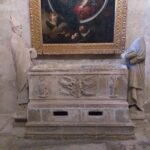Our Lady of Guadalupe
Our Lady of Guadalupe
When she lived: Our Lady of Guadalupe’s apparitions occurred in December 1531.
Where she lived: Our Lady of Guadalupe’s apparitions took place on the Hill of Tepeyac, near present-day Mexico City.
Notable world events during her life:
- Spanish Conquest of the Aztec Empire (1519-1521): Hernán Cortés and his forces conquered the Aztec Empire, which had a profound impact on the region, including the subsequent spread of Christianity.
- Protestant Reformation (1517 onwards): The Protestant Reformation, initiated by Martin Luther’s Ninety-Five Theses, led to the splintering of Christianity and significant religious and political transformations in Europe.
- European Exploration of the Americas (1492 onwards): The ongoing exploration and colonization of the Americas by European powers reshaped the geopolitical landscape and had profound consequences for indigenous cultures.
Her patronage:
Our Lady of Guadalupe is considered the patroness of the Americas and is venerated as the Empress of the Americas. She is also a symbol of unity, evangelization, and protection, and is revered by millions of Catholics worldwide.
The Apparition on Tepeyac Hill
The Blessed Virgin Mary has appeared to privileged men and women over the years. In her apparitions, the Blessed Mother always had important messages that she wished to make known to all her beloved children. Among the numerous apparitions of Our Lady that were thoroughly investigated and solemnly approved by the Catholic Church is her apparition in Guadalupe, Mexico.
According to tradition, Our Lady appeared to an Aztec convert to Christianity named Juan Diego, who was canonized as a saint. The apparitions occurred on December 9 and 12 in the year 1531. In her first apparition, the Blessed Virgin requested that a shrine in her honor be built at the location where she appeared. This spot was Tepeyac Hill, now a suburb of Mexico City. Juan Diego went to the bishop, Juan de Zumárraga, and told him about the Lady’s message and request.
The Bishop’s Doubt and the Lady’s Sign
Doubting about the peasant’s message, the bishop dismissed Juan Diego and demanded a sign before he would approve the construction of the shrine. Mary appeared a second time to Juan Diego, and he told her about the bishop’s order. She ordered him to collect roses, which was impossible because it was winter at that time. To his surprise, Juan Diego found many roses, all in full bloom. He cut these roses and collected them in his cloak.
In a second audience with the bishop, Juan Diego opened his cloak, letting dozens of roses fall to the floor. And lo and behold, the image of Our Lady was revealed, imprinted on the inside of the cloak. This image is now venerated in the Basilica of Guadalupe and bears the title Nuestra Seora de Guadalupe, or Our Lady of Guadalupe.
Disputes and Devotion to the Virgin of Guadalupe
Over the years, the story of this apparition has been questioned by various scholars and ecclesiastics. Objections appeared, such as the fact that there was no documentary evidence for the apparition until 1648. Critics also noted that the bishop approached by Juan Diego was not consecrated until 1534 and made no mention of Juan Diego or of the Lady of Guadalupe in his writings. However, defenders of the Virgin of Guadalupe, including Pope John Paul II, accept the authenticity of the early documents. They also point out various oral accounts of the apparition.
A shrine to the Virgin has existed on the site since at least 1556. The devotion to the Virgin of Guadalupe continued to grow, especially after she was credited with ending a deadly epidemic that ravaged Mexico City in 1736–1737. She was proclaimed patroness of Mexico City in 1737. In 1746, her patronage was accepted by all territories of New Spain, including portions of present-day California, Mexico, and regions as far south as El Salvador and Guatemala. In 1910, Pope Pius X proclaimed her patroness of Latin America. In 1935, Pope Pius XI approved her patronage of the Philippines.
Veneration of Our Lady of Guadalupe has been particularly strong among women, especially in Mexico. Since at least the early 18th century, devotion has been spread throughout the world by the Jesuits and other religious congregations. The feast day of Our Lady of Guadalupe is December 12.
Five Interesting Facts About Our Lady of Guadalupe
- Tradition says that the Virgin Mary herself bundled the flowers into Juan Diego’s cloak, or tilma. These flowers were exotic, and when he presented them to Bishop Zumárraga, the bishop recognized them as Castilian roses, which were not found in Mexico.
- The story of the Virgin’s apparition is best known from a 1556 manuscript written in Nahuatl, the Aztecs’ native language, by the scholar Antonio Valeriano.
- Pope John Paul II, a known devotee and defender of Our Lady of Guadalupe, canonized Juan Diego and declared the Virgin of Guadalupe the Patroness of the Americas.
- An estimated 20 million people visit the Basilica of Our Lady of Guadalupe each year. This basilica is now situated on the very same hill on which she appeared.
- The Virgin of Guadalupe’s role in the history of Mexico is not only limited to religious matters. She has played an important role in Mexican identity and nationalism. In 1810, Miguel Hidalgo y Costilla promoted her as the patroness of the revolt he led against the Spanish, carried the image of the Virgin on the rebels’ banners, and had their battle cry “Long Live Our Lady of Guadalupe.”
Prayer to Our Lady of Guadalupe
O God, Father of mercies, who placed your people under the singular protection of your Son’s most holy Mother, grant that all who invoke the Blessed Virgin of Guadalupe may seek with ever more lively faith the progress of peoples in the ways of justice and of peace. Through our Lord Jesus Christ, your Son, who lives and reigns with you in the unity of the Holy Spirit,God, for ever and ever Amen.



